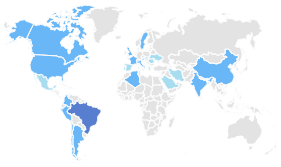Gibraltar Strait Bimarian Barrier (GSBB)
Resumo
On-land construction of most of the inexpensive elements of an impermeable durable “fabric” sea-dam separating the Mediterranean Sea from the North Atlantic Ocean will allow speedy installation and early finished facility first use. Despite the vast science-predicted geographical change, including climate change, within the existing Mediterranean Sea Basin we anticipate subsequent built sea-dam “close enough” near-maintenance of the regional environmental status quo; consider encouragement of in-Basin smaller adaptive macroprojects as well as an efficient and sparely organized International Caretaker Council operational authority to be established before 2050-2100 AD. With sea-locks and siphonic small-scale electric power generators allowing seawater inflows, the GSBB can match Basin evaporation with a compensating controlled seawater inflow from the North Atlantic Ocean, keeping most conditions as they are today. The Suez Canal’s single sea-lock will work similarly and in tandem with the GSBB. The engineering challenge is to handle a salty fluid that is > 800% denser than air! Successful performance of the GSBB will come in time if the macroproject’s planning, execution and handover are up to standard practice. If it judged a failure, the cost of its removal will not be financially onerous or prolonged in time.
Keywords: Macro-engineering, artificially stabilized Mediterranean Sea, marine transgression, flexible sea-dam, future climate change, North Atlantic Ocean, navigational alterations, supportive macroproject components, GSBB.
===========================================================================
A construção em terra da maioria dos elementos baratos de uma barragem marítima de “tecido” impermeável e durável que separe o Mar Mediterrâneo do Oceano Atlântico Norte permitirá uma instalação rápida e uma utilização antecipada do sistema. Apesar da vasta mudança geográfica prevista pela ciência, incluindo as alterações climáticas, dentro da Bacia do Mar Mediterrâneo existente prevemos que a subsequente construção de barragens marítimas dará conta da quase manutenção do status quo ambiental regional; considere-se o incentivo a macroprojectos adaptativos menores na Bacia, bem como a autoridade operacional eficiente e organizada de um Conselho Interno Internacional, a ser estabelecido antes de 2050-2100 DC. Com eclusas marítimas e geradores de energia eléctrica sifónicos de pequena escala que permitam a entrada de água do mar, o GSBB pode combinar a evaporação da Bacia com uma entrada de água do mar controlada e compensatória do Oceano Atlântico Norte, mantendo a maioria das condições como são hoje. A eclusa marítima única do Canal de Suez funcionará de forma semelhante e em conjunto com a GSBB. O desafio da engenharia é lidar com um fluido salgado que seja > 800% mais denso que o ar! O desempenho bem sucedido da GSBB chegará a tempo se o planeamento, a execução e a transferência do macroprojecto estiverem de acordo com a prática padrão. Se for considerado um fracasso, o custo da sua remoção não será financeiramente oneroso nem prolongado no tempo.
Palavras-chave: Macroengenharia, Mar Mediterrâneo estabilizado artificialmente, transgressão marinha, barragem marítima flexível, futuras alterações climáticas, Oceano Atlântico Norte, alterações de navegação, componentes de macroprojectos de apoio, GSBB.
Texto completo:
PDFReferências
Hinkel, J.; Vafeidis A.T.; Perrette, M.; Nicholls, R.J. Coastal
flood damage and adaptation cost under 21st century sea-level rise.
PNAS 2014 111, 3292-3297.
Sengputa, D.; Choi, Y.R.; Tian, B.; Brown, S.; Meadows, M.;
Hackney, C.R.; Bannerjee, A.; Li, Y.; Chen, R.; Zhou, Y. Mapping
st Century Global Coastal Land Reclamation. Earth’s Future 2023
, e2022EF002927.
Margulis, L.; Living by Gaia. 2016 In Talking on the Water:
Conversations about Nature and Creativity, edited by Johnathan
White, 76. San Francisco: Sierra Club Books.
Went, F.W. The Size of Man. American Scientist 1968 56,
-413.
Prather, M.J.; Hsu, J.C. A round Earth for climate models.
PNAS 2019 116, 19330-19335.
Beckage, B.; Lacasse, K.; Winter, J.M.; Gross, L.J.; Fefferman,
N.; Hoffman, F.M.; Metcalf, S.S.; Franck, T.; Carr, E.; Zia, A.;
Kinzig. A. The Earth has humans, so why don’t our climate models?
Climatic Change 2020 163, 181-188.
Apontamentos
- Não há apontamentos.
Direitos autorais 2023 Richard B. Cathcart, Charles W. Finkl
Indexadores, Diretórios, Bases de Dados e Registros (Abstracted and Indexed in):

CALIBRE - Revista Brasiliense de Engenharia e Física Aplicada
ISSN Eletrônico: 2526-4192































